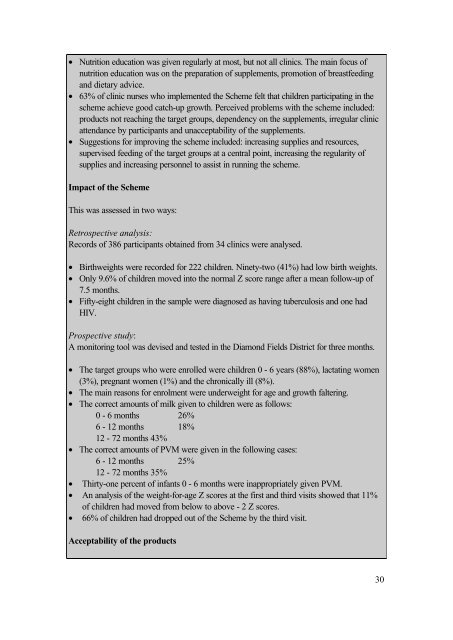Implementing an Integrated Nutrition Programme - Health Systems ...
Implementing an Integrated Nutrition Programme - Health Systems ...
Implementing an Integrated Nutrition Programme - Health Systems ...
Create successful ePaper yourself
Turn your PDF publications into a flip-book with our unique Google optimized e-Paper software.
• <strong>Nutrition</strong> education was given regularly at most, but not all clinics. The main focus of<br />
nutrition education was on the preparation of supplements, promotion of breastfeeding<br />
<strong>an</strong>d dietary advice.<br />
• 63% of clinic nurses who implemented the Scheme felt that children participating in the<br />
scheme achieve good catch-up growth. Perceived problems with the scheme included:<br />
products not reaching the target groups, dependency on the supplements, irregular clinic<br />
attend<strong>an</strong>ce by particip<strong>an</strong>ts <strong>an</strong>d unacceptability of the supplements.<br />
• Suggestions for improving the scheme included: increasing supplies <strong>an</strong>d resources,<br />
supervised feeding of the target groups at a central point, increasing the regularity of<br />
supplies <strong>an</strong>d increasing personnel to assist in running the scheme.<br />
Impact of the Scheme<br />
This was assessed in two ways:<br />
Retrospective <strong>an</strong>alysis:<br />
Records of 386 particip<strong>an</strong>ts obtained from 34 clinics were <strong>an</strong>alysed.<br />
• Birthweights were recorded for 222 children. Ninety-two (41%) had low birth weights.<br />
• Only 9.6% of children moved into the normal Z score r<strong>an</strong>ge after a me<strong>an</strong> follow-up of<br />
7.5 months.<br />
• Fifty-eight children in the sample were diagnosed as having tuberculosis <strong>an</strong>d one had<br />
HIV.<br />
Prospective study:<br />
A monitoring tool was devised <strong>an</strong>d tested in the Diamond Fields District for three months.<br />
• The target groups who were enrolled were children 0 - 6 years (88%), lactating women<br />
(3%), pregn<strong>an</strong>t women (1%) <strong>an</strong>d the chronically ill (8%).<br />
• The main reasons for enrolment were underweight for age <strong>an</strong>d growth faltering.<br />
• The correct amounts of milk given to children were as follows:<br />
0 - 6 months 26%<br />
6 - 12 months 18%<br />
12 - 72 months 43%<br />
• The correct amounts of PVM were given in the following cases:<br />
6 - 12 months 25%<br />
12 - 72 months 35%<br />
• Thirty-one percent of inf<strong>an</strong>ts 0 - 6 months were inappropriately given PVM.<br />
• An <strong>an</strong>alysis of the weight-for-age Z scores at the first <strong>an</strong>d third visits showed that 11%<br />
of children had moved from below to above - 2 Z scores.<br />
• 66% of children had dropped out of the Scheme by the third visit.<br />
Acceptability of the products<br />
30
















